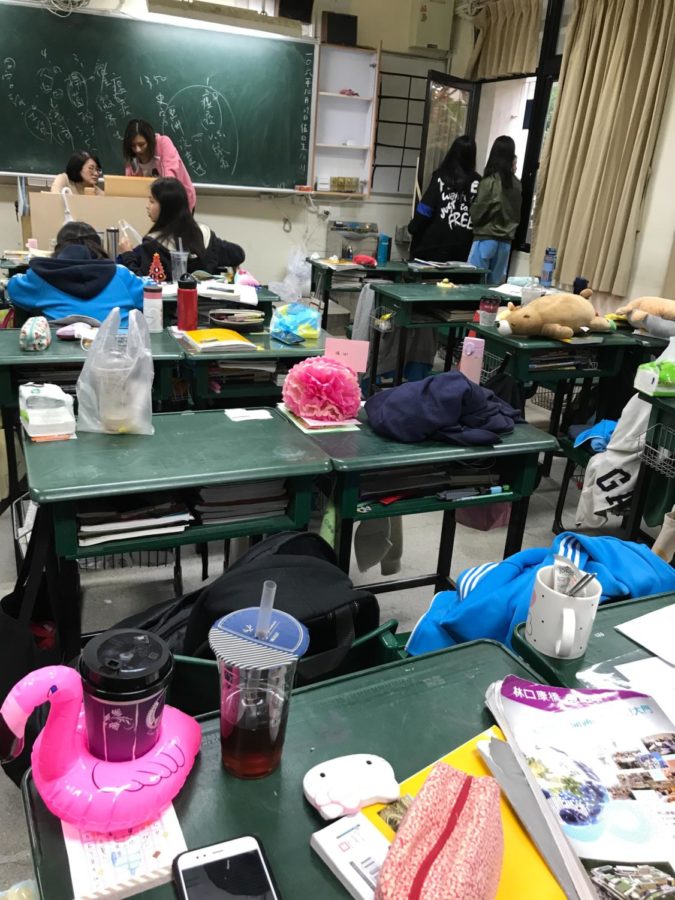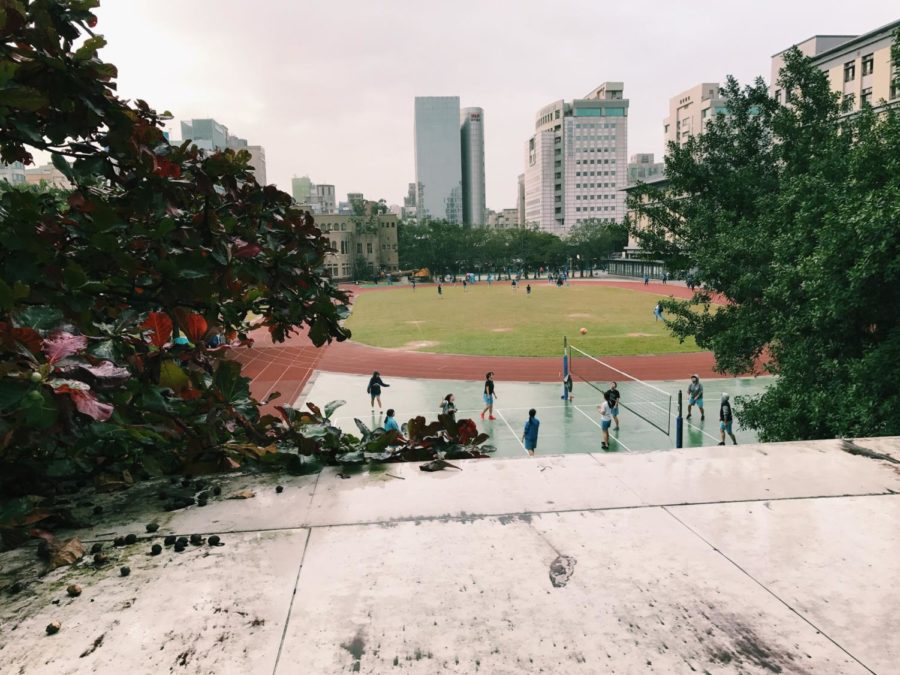students have class in the same classroom throughout the day, with a break time between each class
A day in the life of a Taiwanese student
In a brunch cafe somewhere in the middle of Taipei, Taiwan, my cousin Yui Chao leaned over a stack of strawberry waffles, her mouth covered so the girl beside us wouldn’t hear what she had to say.
“Do you see that green shirt?” Yui Chao said, “That’s how you know.”
That’s how she knew the girl attended Taipei First Girls High School, she went on to explain. That green shirt was a symbol of the girl’s success; it showed that she was a student at Taiwan’s most prestigious girl’s high school. In order to be admitted, students had to score in the top 1 percent on the nationwide high school entrance exam, the Basic Competence Test.
It was 2015 then. For my cousin, it was the year of prepping for the high school entrance exam, better known to her as “The Year of Hell.” Her goal by the end of it all was to wear that same green colored shirt and to be able to ride the Taipei Metro back home after school with the confidence that everyone on the train would know she was smart.
When I was two years old, my parents considered moving to Taiwan, the island where my mother was born. If that was the case, I would’ve endured the same educational track that she did; the same track that my cousin is currently on. Part of the decision behind staying in Minnesota, my mother said, was so my brothers and I could avoid the “test culture” fate.
As a junior, this is the year that I’ve taken the PSAT and ACT; I’ll also be taking the SAT come spring. With AP prep books and practice exams duplicating on my desk like rogue cells, it’s been frustrating to have my exam experiences written off as a lesser version of the pain Taiwanese students struggle through. At the same time, I’ve always been curious: if my parents had decided to put me in a Taiwanese desk, how different of a person would I be?
In December of 2017, I returned to Taiwan to spend the holidays with my grandparents. I was only able to spend time with my cousin during the weekends, as she still had school; her holiday break wouldn’t come until Chinese New Year in February. One afternoon, however, I was able to spend time with her at Zhongshan Girls High School, the third ranked high school in the country (tied with its brother school). Curious about what school would’ve been like for me, I asked if I could sit in on a few of her classes.
Her classroom almost resembled a bedroom, partly because of the degree to which it was personalized–the green desks were covered in stuffed animals and magnets, with tissue boxes and tote bags hanging off the sides–and partly because of the four girls napping during the ten minute passing time. Because the teacher for each subject came to the classroom, rather than the students walking to different rooms for each subject, the students at Zhongshan seemed to have made themselves comfortable.
Yui Chao wanted to bring me to the canteen so I could have my favorite breakfast food–dan bing, an “egg crêpe” street vendor dish–but despite typically being available to students throughout the day, it was closed. Instead, my cousin lead me to the two story library through rain-stained tile halls. Up there, surrounded by bookshelves and study spaces, we had a bird’s eye view of the campus.
The school campus, which was founded in 1897 under Japanese rule, was made up of tiled buildings that encircled a track, field and volleyball court. Each grade level–10th, 11th and 12th–had its own building. In the Zi-Jiang Building for 11th graders, corridors were on balconies, so when it started to rain the soothing sound resonated across campus.
The more energized students opted to play volleyball in the courtyard, or run laps around the track. Most Taiwanese high schools, while offering physical education classes, do not offer athletics programs. As a result, it’s up to students to join sports clubs unaffiliated with a school or start pick-up games if they wish to play on a team.
I watched groups of girls conglomerate around the balcony pillars. As they chatted quickly in Chinese, I was struck with a realization. In another version of my life, I could’ve stood among them too. Perhaps I would’ve sat in my own green desk and listened to headset wearing teachers give lessons on Taiwanese civics. Maybe, instead of learning English on an AP level, I would’ve filled grammar worksheets, mastering English in the most fundamental way.
Regardless, the bell rang and Yui Chow and I returned to the same classroom she started in at 8:10 a.m. and would leave at 5:10 p.m. The two teachers’ classes I sat in on didn’t fit the strict “Asian stereotype” of silent classrooms and anal teachers. During math class, one girl offered to take the teacher’s son out to dinner in exchange for a later test date. The class let out a long, collective plead–to no avail–the teacher only laughed and said to turn to page 57. Like all schools, Yui Chao said, hers had some teachers who were less strict than others. I happened to sit in on one of the student favorites.
While at first glance the colorful classroom, decked with girls pushing the limits on their school uniforms, might have seemed like a relaxed environment, the truth in the difference between the Taiwanese and American school system is much steeper.
As an American high school student I am all too familiar with standardized tests and their weight in the college admissions process. A quick Google search can find the test scores deemed necessary for admittance to specific colleges, as if there’s an unspoken benchmark to even be considered a worthy applicant. The key word here is “unspoken.” As in, most American colleges do not have literal benchmarks. On the other side of the ocean, however, those benchmarks are indeed “spoken.” As a matter of fact, they are inked into documents.
Each university in Taiwan has a required score for admittance, as well as individual required scores for specific programs. This means that both the colleges Taiwanese students can go to as well as which major they can choose is dictated by a test score. The first test attempt is the General Scholastic Ability Test, which is taken senior year of high school and assesses students on their mathematics, English, Chinese, and natural and social science abilities, according to the Executive Yuan.
Attempt no. 2 is the Advanced Subject Test. Dr. Bernard Li, president of the College Entrance Examination Center (the administration that designs the standardized tests, along with the Ministry of Education) explained how the AST works in an interview with a Fu Jen Catholic University student. If students are displeased with their GSAT score, they can opt to take three subject tests and apply their scores to a specific university program. Score benchmarks still exist.
While there have been recent modifications to the college entrance process, such as accommodations for students from rural areas or a path for outstanding athletes, the two major paths to college are the GSAT and AST. Admittance is beginning to sway away from just the test scores, but the “test culture” is still etched deeply into the fabric of Taiwan.
“Teachers always make the students put their efforts into useless memorizing…although there’s some changes done by young teachers…the majority still view their efforts as ‘a waste of time’ because the test doesn’t really need it,” Municipal Chenggong High School junior Lin Po Ru said.
When I asked my mother, Wei Chi Spencer, about her view on the Taiwanese education system, she was hesitant to get in too deep. “Teachers and students don’t have a clear picture about which direction to go,” she said, “To be honest with you, it is too complicated to write about.”
There is some truth to what she said. The history of Taiwan’s educational “trial and error period,” as my mother put it, is extensive, complicated further by periods of rule by Japan and China. Comparing the American education system to the Taiwanese education system is like comparing a 3.8 million square mile land mass to a 13,974 square mile island. Because that’s what they are. Two distinct nations with drastically different high school senior populations to divide into colleges.
Their boiled down difference, however, comes down to the importance of standardized tests. While test scores may seem overemphasized in America, the emphasis in Taiwan is even more bold.
At times I’ve wondered if being a Taiwanese student would have suited me better. Instead of feeling pressured to have service, leadership, athletic and academic skills under my belt–not to mention the ability to take a timed test–maybe being able to focus on achieving one part of the well-rounded American student image would have been nice: just the ability to take a test.
Over the years, I’ve continuously come back to the same question: would going to school in Taiwan have been better? And time after time, despite the occasional day dream, I’ve reached the same conclusion. Yes, there will probably always be flaws in the American education system, and yes, improvements to that system should continue to be made, but there is merit to the intentions of America’s current school system; a system that attempts to encourage skills beyond filling out a Scantron. It may be a work in progress, but at least the momentum is positive.


